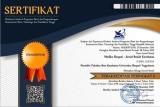RANCANG BANGUN PROTOTIPE 3 DIMENSI ORGAN MANDIBULA MENGGUNAKAN CITRA MEDIS RADIOLOGI
DOI:
https://doi.org/10.35842/mr.v17i4.762Keywords:
3D prototypes, mandible, CT-Scan images, reconstructive surgery, healthcareAbstract
Latar belakang: Tumor pada mandibula dapat menyebabkan kecacatan tulang. hal ini memberikan dampak negatif pada kehidupan sosial penderita. Solusi pada kasus ini adalah operasi rekonstruksi mandibula. Untuk mengoptimalkan operasi tersebut salah satunya dapat digunakan prototipe 3D sebagai perencanaan pra-bedah. Tujuan: Penelitian ini berfokus pada proses pembuatan prototipe 3D yang menggunakan pencitraan dari modalitas CT-Scan. Hasil: Pembuatan prototipe 3D diawali dari akuisisi data citra CT-Scan yang selanjutnya dilakukan proses segmentasi citra dan visualisasi 3 dimensi, pada proses terakhir dilakukan pencetakan 3 dimensi. Prototipe 3D yang telah jadi dilakukan analisa kualitatif melalui pengukuran dimensi panjang di daerah ramus, angulus, dan body of mandible dan dibandingkan dengan hasil pengukuran organ mandibula cadaver. Didapatkan hasil rerata panjang ramus pada mandibula cadaver adalah 33,62±0,34 mm, sedangkan panjang ramus pada mandibula prototipe 3D adalah 32,98±0,44 mm. Nilai rerata pengukuran pada daerah angulus adalah 31,26±0,25 mm pada mandibula cadaver, dan nilai 31,23±0,22 mm pada mandibula protptipe 3D. Dan pengukuran pada daerah body of mandible mandibula cadaver adalah 32,05±0,98mm, sedangkan apada mandibula prootipe adalah 32,06±1,03 mm, secara keseluruhan akurasi pada prototipe 3D sebesar 99,317%.  Kesimpulan: Penggunaan citra radiologi sebagai data awal untuk membuat prototipe 3 dimensi mandibula dapat dilakukan, pengukuran akurasi prototipe 3D harus dievaluasi untuk masing-masing tahap fabrikasi.
References
Agarwal, R. et al. (2022) ‘The application of Three-dimensional printing on foot fractures and deformities: A mini-review, Annals of 3D Printed Medicine, 5(January), p. 100046. DOI: 10.1016/j.stlm.2022.100046.
Aydin, S., Kucukyuruk, B. and Sanuz, G. (2011) ‘Cranioplasty: Review of Material and Techniques’, Neurosci Rural Pract, 2, pp. 162–167. DOI: 10.4103/0976-3147.83586.
Baradeswaran, A., L, J. S. and R, P. P. (2014) ‘Reconstruction of Images into 3D Models using CAD Techniques’, 3(1), pp. 1–8.
Betancourt, L. G. et al. (2022) ‘Utility of Three-Dimensional Printed Model in Biventricular Repair of Complex Congenital Cardiac Defects: Case Report and Review of Literature, Children, 9(2). DOI: 10.3390/children9020184.
Bozkurt, Y. and Karayel, E. (2021) ‘3D printing technology; methods, biomedical applications, future opportunities, and trends, Journal of Materials Research and Technology, 14, pp. 1430–1450. DOI: 10.1016/j.jmrt.2021.07.050.
Cahyandari dini (2016) ‘Review : Rapid Prototyping Technology Untuk AplikasiPembuatan Implan Tulang Dan Gigi’, 16(1), pp. 38–40.
Chen, X. et al. (2019) ‘Learning active contour models for medical image segmentation, Proceedings of the IEEE Computer Society Conference on Computer Vision and Pattern Recognition, 2019-June, pp. 11624–11632. DOI: 10.1109/CVPR.2019.01190.
Dupret-Bories, A. et al. (2018) ‘Contribution of 3D printing to mandibular reconstruction after cancer, European Annals of Otorhinolaryngology, Head and Neck Diseases, 135(2), pp. 133–136. DOI: 10.1016/j.anorl.2017.09.007.
Fadillah, N. and Gunawan, C. R. (2019) ‘Segmentasi Citra Ct Scan Paru-Paru Dengan Menggunakan Metode Active Contour’, JURIKOM (Jurnal Riset Komputer), 6(2), pp. 126–132.
Fernandes da Silva, A. L. et al. (2014) ‘Customized Polymethyl Methacrylate Implants for the Reconstruction of Craniofacial Osseous Defects’, Case Reports in Surgery, 2014, pp. 1–8. DOI: 10.1155/2014/358569.
Kartikasari, A. et al. (2018) PRODUKSI PROTOTIPE 3 DIMENSI ORGAN MANDIBULA DENGAN METODE SEGMENTASI CITRA CT-SCAN. Universitas Airlangga.
Li, C. et al. (2017) ‘Applications of three-dimensional printing in surgery’, Surgical Innovation. DOI: 10.1177/1553350616681889.
Marconi, S. et al. (2022) ‘Quantitative Assessment of 3D Printed Blood Vessels Produced with J750TM Digital AnatomyTM for Suture Simulation’, bioRxiv, p. 2022.01.09.475308. Available at: https://www.biorxiv.org/content/10.1101/2022.01.09.475308v1%0Ahttps://www.biorxiv.org/content/10.1101/2022.01.09.475308v1.abstract.
Odeh, M. et al. (2019) ‘Methods for verification of 3D printed anatomic model accuracy using cardiac models as an example, 3D Printing in Medicine, 5(1), pp. 1–12. DOI: 10.1186/s41205-019-0043-1.
Otton, J. M. et al. (2017) ‘3D printing from cardiovascular CT: A practical guide and review’, Cardiovascular Diagnosis and Therapy, 7(5), pp. 507–526. DOI: 10.21037/cdt.2017.01.12.
Rengier, F. et al. (2010) ‘3D printing based on imaging data: Review of medical applications, International Journal of Computer Assisted Radiology and Surgery, 5(4), pp. 335–341. DOI: 10.1007/s11548-010-0476-x.
Siregar, R. A., Siahaan, M. Y. R. and Juliansyah, R. (2021) ‘Simulasi Numerik tentang pengaruh geometri mandibula yang direkonstruksi terhadap tegangan von Mises’, Journal of Mechanical Engineering Manufactures Materials and Energy, 5(2), pp. 187–193. doi: 10.31289/jmemme.v5i2.5349.
Yang, L. et al. (2016) ‘Application of 3D Printing in the Surgical Planning of Trimalleolar Fracture and Doctor-Patient Communication’, BioMed Research International, 2016. DOI: 10.1155/2016/2482086.




